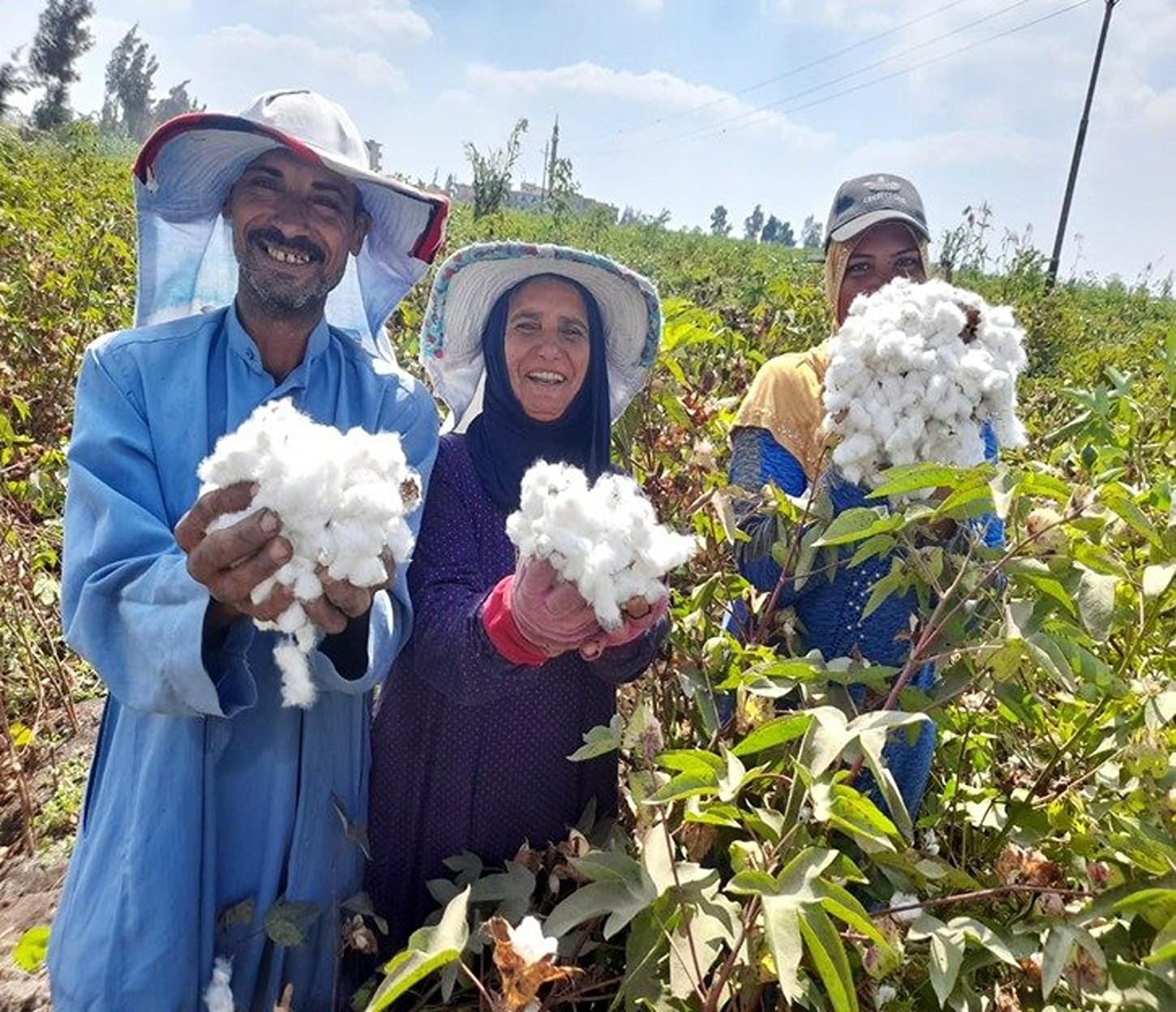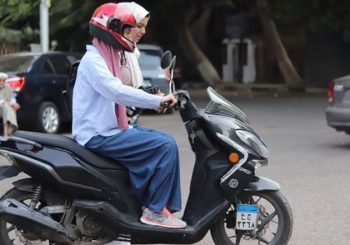A single, humble cotton crop, though small, carries the weight of the world. For Egypt, it has long been a source of pride and wealth, often dubbed its “white gold,” with exports increasing by 36.5 percent in 2023, reaching 1.5 million metric quintals compared to 1.1 million metric quintals in 2022.
Yet, for farmers like Rabeha Al-Habashi, it represents so much more than just a crop; it is a family legacy, a passion, and a promise of growth.
Al-Habashi, a cotton farmer from Samul village in El Gharbiya Governorate, typically takes about six months to grow and harvest her crop. However, due to the impacts of climate change and extreme heat, she lost years’ worth of productivity. The best way to describe the effects of climate change is that it feels like someone pressed a pause button on her life. Her struggles mirror a larger pattern for global agriculture, as research shows that climate change has erased roughly seven years of progress in agricultural productivity over the last six decades.
After joining CottonConnect’s REEL Cotton Programme in 2023, she became a regenerative cotton farmer, using agricultural practices that improve soil health and the ecosystem.
In one year, she has become a local leader on climate change, teaching her community about the importance of regenerative agriculture, as well as passing on new skills, such as making organic fertilizer from kitchen scraps to improve soil health, which saves farmers money to support their families.
To extend their reach and support more farmers, CottonConnect and the Cotton Egypt Association (CEA) have formalized a long-term partnership in early October, aiming to raise awareness and expand regenerative cotton programs across Egypt, further bolstering the REEL Regenerative Programme.
Defining regenerative cotton

Unlike sustainability, which primarily emphasizes reducing environmental harm, regeneration seeks to increase the positive impact on both the environment and communities.
Primarily, regenerative agriculture focuses on practices that help to improve soil health, encourage biodiversity, promote water efficiency and reduce greenhouse gas emissions whilst also supporting farmers to diversify their incomes and become more resilient to climate change. This forward-thinking approach, coined by the Rodale Institute in the 1980s, reflects a commitment to building a thriving ecosystem that benefits all stakeholders involved.
Farmers enrolled in the program are trained in a range of regenerative agricultural practices. They learn techniques to conserve water, such as on-farm water harvesting, and maintain ecosystem health through methods like crop rotation. They are also taught to identify and manage pests using non-chemical methods, reducing the need for harmful pesticides. These practices lower input costs and protect the long-term health of the soil.
When it comes to producing regenerative cotton, there is so much more to it than reducing emissions. It is also about cutting back on water usage, chemical fertilizers, and pesticides, as well as improving the lives of cotton farmers through higher incomes and fairer social practices.
Traditionally, cotton production has been a significant environmental concern. Heavy pesticide and fertilizer use degrades soil health, while conventional farming practices release harmful emissions. On top of that, cotton cultivation’s high water demand exacerbates water scarcity risks.
Beyond environmental concerns, the human impact of cotton production is also significant.
Smallholder cotton farmers have long struggled with low profitability, primarily due to the rising costs of seeds, fertilizers, and water for irrigation. Egypt suffers from significant water shortages, and according to the United Nations, Egypt is predicted to be categorized as water scarce by 2025. Climate change has also led to crop losses due to unprecedented temperature increases.
A report by Cotton 2040 warns that by 2040, rising temperatures could shorten growing seasons in 40 percent of cotton-producing regions, while drought could impact half of the global crop. Farmers have also largely depended on word-of-mouth and what they have observed from older generations or neighbors, making formal training in regenerative agricultural techniques often scarce in their communities.
To tackle these urgent challenges and enhance both productivity and profitability for farmers, CottonConnect introduced its REEL program in Egypt in 2022. Initially supporting 145 smallholder farmers, the program focused on regenerative agricultural techniques aimed at improving soil health and optimizing water management. In 2023, the Women in Cotton program was also established to empower 25 female farmers from Samul village.
Since its inception, the initiative has expanded its reach, now empowering over 350 farmers. To strengthen relationships with the farming community, CottonConnect has additionally established partnerships with prominent local organizations, including the Cotton Research Institute (CRI) and El Ekhlas.
“We trained farmers on nourishing their land and introduced practices like intercropping sorghum with their cotton to attract birds. These birds naturally control pests, reducing the need for harmful pesticides,” Alisan Ward, CEO of CottonConnect, explained to Egyptian Streets. “These methods not only benefit the environment but also enhance farmers’ income, livelihoods, and resilience to climate change.”
Based on research and surveys conducted with local farmers, CottonConnect’s REEL program employs a holistic framework focused on both the community and the environment and designed to continuously renew the land and enhance the overall environmental quality.
This initiative aims to mitigate resource depletion to restore the land, boost productivity, and improve ecological health through advanced farming practices. These practices include transitioning to the preparation and application of homemade biopesticides as a replacement for traditional chemical alternatives.
“Our preliminary assessment of the Egyptian program revealed significant progress. We observed a 15-30 percent reduction in water and chemical usage, increased crop yields, and a one-third boost in profits for participating farmers,” Ward noted.
These results are illustrated through the case of Mohamed Ramadan, a long-time cotton farmer in Egypt, who has adopted sustainable farming practices through the REEL Cotton Programme.
By following the advice of an agronomist, he has significantly reduced his use of chemical pesticides, applying them only five times in last year’s season compared to eight times the previous year. Instead, he has utilized biopesticides tailored to his specific agro-ecosystem, which has promoted the natural enemies of pests and increased biodiversity on his one-acre farm.
Taking regenerative agriculture to the field
Farmers in Egypt, like many others, learn best through hands-on experience and observation. Without practical training involving community members, it becomes difficult for these farmers to maintain a strong connection to their agricultural heritage.
This interconnectedness, akin to the butterfly effect, demonstrates how small changes in individual farming practices can lead to substantial improvements in overall crop yields. When a farmer successfully implements regenerative practices and experiences increased profits, it inspires neighboring farmers to follow suit. A single local leader can catalyze significant change within a community, although widespread adoption may take several years to spread to surrounding villages.
To expedite the process, CottonConnect organized extension visits and field trips with CRI researchers to local farmers. These visits introduced farmers to demonstration plots, where they collaborated with experts to experiment with various agricultural practices, crops, livestock, and technologies.
“Our local consultants in Egypt have collaborated with global CottonConnect experts to share knowledge, evaluate field feedback, and implement necessary follow-up actions with farmers,” Ward stated.
To build the capacity of farmers in Egypt, two key approaches are being implemented: training of Trainers (TOT) programs and Farmer Field Schools (FFS). The goal is not only to impart new skills, but also to build local leaders who can disseminate knowledge within their communities.
Farmers receive monthly visits throughout critical stages of cotton production, including germination and emergence, leaf area and canopy development, flowering and boll development, maturation, and harvesting. A demonstration plot is also established for a specific training module or practice tailored to local groups, providing farmers with a firsthand experience of the benefits of regenerative farming.
“These regular visits facilitate meaningful discussions and trust to provide comprehensive support to farmers at each phase of the cultivation process,” Ward noted. “Local farmers are central to the cotton supply chain, and by collaborating with them, we drive broader changes in agriculture.”
What’s next in regenerative cotton?
Working directly with farmers is a crucial step, but it is just one piece of the puzzle. The supply chain extends further, encompassing fashion brands and retailers who must also embrace regenerative cotton practices.
Despite economic challenges, Egypt remains an attractive market for cotton exports due to its production of extra-long-staple cotton; a rare and luxurious variety that is renowned for its luster and softness.
As part of the new memorandum of understanding (MOU) between CottonConnect and the CEA, which aims to expand the REEL Program, the partnership will target other stages of the supply chain. This includes developing a traceability model for Egyptian cotton, tracking its journey from farm to fashion, and exploring joint opportunities with local and international brands interested in producing regenerative cotton.
As consumers grow increasingly mindful of their purchasing choices, CottonConnect and CEA will bridge the gap between brands and the farmers at the heart of the supply chain, as many brands are striving to achieve 100 percent traceable materials by 2030.
This agreement arrives at a critical juncture as Egypt’s cotton industry prepares to reclaim its global stature. With a 36.5 percent surge in cotton exports for the 2022/2023 season, Egypt now aspires to restore its historical prominence and pioneer a new era of regenerative cotton cultivation.







Comments (0)